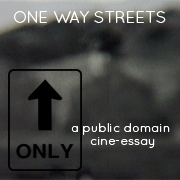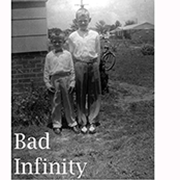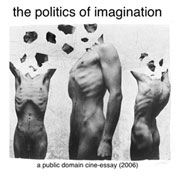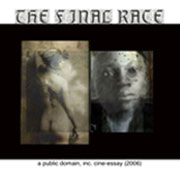| c i n e – e s s a y: An odd hybrid of the documentary and experimental form, the essay film couples visual — usually documentary — images with extensive narration to create an idiosyncratic, often reflexive, thesis. These films generally skew all forms of conventions of both fiction and mainstream non fiction films: there is no plot as such and few interviews. Instead there is solely the argument of the film. The themes that this style addresses often concern the nature of representation, time, memory, history and the medium of cinema itself. | ||||||||||||
 |
One-way Streets (2017). At each step and at each moment one rediscovers a self inside a system of values that has no other aim than to conceal and tame all the irrational by which life linked to earth is driven. Are we, then, insane because we have not gone mad? ― Hermann Broch, The SleepwalkersIt is light that prevents us from seeing, it is the ability to give meaning that abandons us to the imperceptible action of what is hidden behind meaning and acts through this very dissimulation. (M.Blanchot)
Preview (below) TRT: 5:00 |
PurchaseIndividuals: $19.99
Institutions: $199.99 |
||||||||||
 |
Speaking in Tongues (2017). Glossolalia (from the Greek, (glossa), tongue and (lalô), I speak) comprises unintelligible utterances, often as part of religious practice. Glossolalia is claimed by some to be an unknown mystical language; others claim that glossolalia is the speaking of an unlearned foreign language (xenoglossia).
Preview (below) TRT: 5:00 |
PurchaseIndividuals: $19.99
Institutions: $199.99 |
||||||||||
 |
OTHER rhythms (2016). a wave of concentric circles ripple from thrown skipping stones appearance diminishing presence to absence the pattern spreading like a cat’s-paw haunting the water ocean breaks and spills onto white sand water echoes through time and tempo stealing deeper into the lost desert light at ocean’s edge unknown
Preview (below) TRT: 5:00 |
PurchaseIndividuals: $19.99
Institutions: $199.99 |
||||||||||
 |
sans_âme (2013) A Phantom I The Darkness In the mournful vaults of fathomless gloom To which Fate has already banished me, Where a bright, rosy beam never enters; Where, alone with Night, that sullen hostess, I’m like a painter whom a mocking God Condemns to paint, alas! upon darkness; Where, a cook with a woeful appetite, I boil and I eat my own heart; At times there shines, and lengthens, and broadens A specter made of grace and of splendor; By its dreamy, oriental manner,When it attains its full stature, I recognize my lovely visitor; It’s She! dark and yet luminous.–Charles Baudelaire A vague meditation on caliginosities. Nudity; explicit sexual acts.
Preview (below) TRT: 0:57 |
PurchaseIndividuals: $19.99
Institutions: $199.99 |
||||||||||
 |
Bad Infinity (‘schlechte Unfindlichkeit’) vs. Rumors of Other Worlds; OR: Halo My Baby, Halo my Honey, Halo My Rag Time Doll (2008) Always a cracking point, a fold, measured in the face as time The squirming meeting of temporal strategies, The charred remains co-existing with the fresh paint Of new skin, cicatrix mounding at the edge Threshold, support, cleavage new trinity same as the old trinity maybe, book of ages, amounting to ageless sepia, nothing less nothing more pale glow persisting through memory and masonry, creating memory shooting out in all directions falling back on itself singular apparition hat moulded to head halo irreducible closeness from far far away over and over again damp and dry coexisting on a scale of from one to zero infinitely filled dense with bone
Preview (below)Preview (below) TRT: 5:00 |
PurchaseIndividuals: $19.99
Institutions: $199.99 |
||||||||||
 |
Imagen del Hombre Nuevo (2007). Ernesto Guevara de la Serna (June 14, 1928 ? October 9, 1967), commonly known as Che Guevara or El Che, was an Argentine-born Marxist revolutionary, doctor, political figure, and leader of Cuban and internationalist guerrillas. After his death, Guevara became an icon of socialist revolutionary movements worldwide. An Alberto Korda photo of him (shown) has received wide distribution and modification. The Maryland Institute College of Art called this picture “the most famous photograph in the world and a symbol of the 20th century..”
Preview (below) TRT: 5:00 |
PurchaseIndividuals: $19.99
Institutions: $199.99 |
||||||||||
 |
The Politics of Imagination (2006). History in general, and the twentieth century in particular, had a great deal of trouble with the idea of the imagination as an active psychological element. Although now fallen from its historically high cerebral throne to some faculty belonging to what are essentially non-cerebral systems, such as television, nevertheless the word imagination still smacks of mysticism, of dangerous primitivism, indeed of the occult. The intellect can make convincing things, the emotions can give deep humanmoral understanding, but though the imagination is an element in all this activity, pure imagining for its own sake is far less understood, and has always been a most curious and awesome element of the human personality. In its purest form it appears to have no directly worthy social role, other than as a casual inspiration for mere entertainments. The imagination therefore, appears to be a great anarchic loose cannon of the mind which knows hardly a difference between the sleeping and waking life; its many busy simultaneous levels are still psychologically baffling, and its penchant for making endless patterns which are quite independent of personal needs or directed collective goals is as disturbing to us as it was to Antiquity. More often than not, the imagination lacks all efficiency and focus, and quite unlike the intellect and the emotions, with which it has an endlessly troubled relationship, the singular form of imagination more often than not refuses to be tasked, tamed, directed, or even communicated with. — Colin Bennett
Preview (below) TRT: 5:00 |
PurchaseIndividuals: $19.99
Institutions: $199.99 |
||||||||||
 |
The Final Race (2006). On September 22, 1906, white mobs poured into the Five Points area of downtown Atlanta intent on racial violence. Enflamed by months of political rhetoric and newspaper sensationalism that fed racial fears and stereotypes, the violence against black citizens spread rapidly to East Atlanta, to Brownsville and Inman Park. In the end at least twelve were dead, hundreds injured, and many blacks, fearful for their lives, fled the city — their fates erased from history. The Final Race includes narrative regarding the race riot itself, as well as commentary on the origins of Pentecostalism, abduction by UFOs, skin, race, the mystery of time and remembrance, and the community-to-come.
Preview (below) TRT: 5:00 |
PurchaseIndividuals: $19.99
Institutions: $199.99 |
||||||||||
 |
names-of-the-father (2006). “The reign of the Name-of-the-Father,” says Jacques-Alain Miller, “corresponds in psychoanalysis to the epoch of Freud. If Lacan extracted it, brought it to light, formalized it, it is not in order to adhere to it, to develop this Name-of-the-Father, but to put an end to it.” Lacan did this, put an end to the Name, when he introduced the notion of names-of-the-father (the crucial details not to be missed here are the use of the plural and the lack of capital letters.) Whereas in the Freudian epoch subjects might still believe in the reality or truth of the Other, in the Name-of-the-Father — in the Lacanian epoch the Other no longer exists as such.
Preview (below) TRT: 5:00 |
PurchaseIndividuals: $19.99
Institutions: $199.99 |
||||||||||
 |
THE MECHANICAL OCCULT (2006). Art was originally an evoker of the dead, a rescuer of the dead (and the living) through mediumistic contact… a shuttle craft across the last abyss … a rattle shaken over a decomposing body … a vision pursued through an induced psychotropic haze or abject bodily exhaustion, then revivification with true hallucinations.Does art still have a psychopompic role to play or has the very speed of transmission / storage precluded even that minimal protestant state? We desire art to come out from some essential place and so art has always gravitated, in one way or another, and before the current era of anti-gravity contraptions which promise to levitate us beyond the ?essential? to the MOST essential, toward the negative … that is, death.The supplement, the prosthesis, now speaks to us of non-orders of being, paratactic arrangements of existence that preclude living/dead — truly a levitation beyond all groundings. This is not a regime of Truth much less ?facticity? … actually … it is a regime perhaps more akin to the simultaneous realm of ?is / is not? that Schrodinger?s quantum cat lives/does not live out unseen in its unopened box …
Preview (below) TRT: 5:00 |
PurchaseIndividuals: $19.99
Institutions: $199.99 |
||||||||||
 |
The Postmodern Animal (2005). What is the relationship between animal and human and to what extent does that relationship suggest and shape ideas about identity and creativity? Is the human somewhere in-between animal and divine? Are we as such a waiting animal, an anxious animal … caught between anticipation and absence? Do we live in time, bound to the temporal … bookended between two absented Others … two eternities?
Preview (below) TRT: 5:00 |
PurchaseIndividuals: $19.99
Institutions: $199.99 |
||||||||||
 |
PD Shorts (2002-2005). The odd, the abstract and things that don’t quite fit:
|
PurchaseIndividuals: $19.99
Institutions: $199.99 |
||||||||||
 |
1956 (2005). The “I” that is responsible for others, the I bereft of selfhood, is sheer fragility, through and through on trial. This I without any identity is responsible for him to whom he can give no response; this I must answer in an interrogation where no question is put; he is a question directed to others from whom no answer can be expected either. The Other does not answer. (Maurice Blanchot, The Writing of the Disaster, 119)
Preview (below) TRT: 5:00 |
PurchaseIndividuals: $19.99
Institutions: $199.99 |
||||||||||
 |
Fog City (2004) is a haunting essay on the interplay of fragments, [re]presentations, reverberations and echoes within history, time, memory and the present. The non-linear narrative floats around San Francisco, switching between past and present, between Height Ashbury and Baghdad. Fog City is an exploration of a city as both an abstract and concrete site of historical cross-currents, conflicts, cultures, change and resistance, and explores the extreme possibility that history may be going nowhere. “It is a blind trajectory. One goes nowhere. The commodity of a goal, even a distant one, does not exist.”
|
PurchaseIndividuals: $19.99
Institutions: $199.99 |
||||||||||
 |
The Intolerable Burden (2003). In the autumn of 1965, sharecroppers Mae Bertha and Matthew Carter enrolled the youngest eight of their thirteen children in the public schools of Drew, Mississippi. Their decision to send the children to the formerly all white schools was in response to a “freedom of choice” plan. The plan was designed by the Drew school board to place the district in compliance with the provisions of the Civil Rights Act of 1964, essential since without compliance, the district would no longer be eligible for financial support from the Federal government. Given the prevailing attitudes, Blacks were not expected to choose white schools. This proved true for all but the Carters.The Intolerable Burden places the Carter’s commitment to obtaining a quality education in context, by examining the conditions of segregation prior to 1965, the hardships the family faced during desegregation, and the massive white resistance, which led to resegregation.In the epilogue, the film poses the dilemma of “education vs. incarceration” – a particular threat to youth of color.While the town of Drew is geographically isolated, the patterns of segregation, desegregation, and resegregation are increasingly apparent throughout public education systems in the United States.
Available from First Run / Icarus Films: |
|||||||||||
| Public Domain, Inc. is a 501-(c)-3 nonprofit organization committed to exploring the intersection of art, theory, technology and community. These projects are original expressions fixed in a tangible form, are protected by copyleft (and in limited cases copyright) and may include some copyrighted material, the use of which has not always been specifically authorized by the copyright owner. Where ever possible we include the name of the author/owner and give them full recognition and credit for the excellent and invaluable work they do. We are making these projects and any other such material available in our efforts to advance understanding of artistic, cultural, political, economic, democratic, scientific, human rights, and social justice issues, etc. We believe this limited usage not only falls within the protection of the First Amendment, but also constitutes a ‘fair use’ of any such copyrighted material. The material contained in these projects is distributed without profit and is not intended to have any commercial use to those who seek access to the included information for research and educational purposes. We strongly encourage the support of all work included in these projects through the purchase of individual artists and writers DVDs, CDs, books and other media. | ||||||||||||
cine-essays
... rarely has reality needed so much to be imagined ...